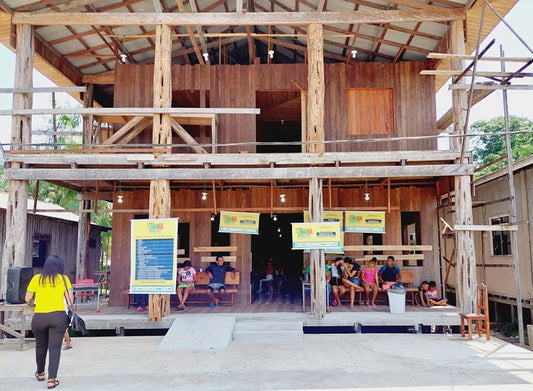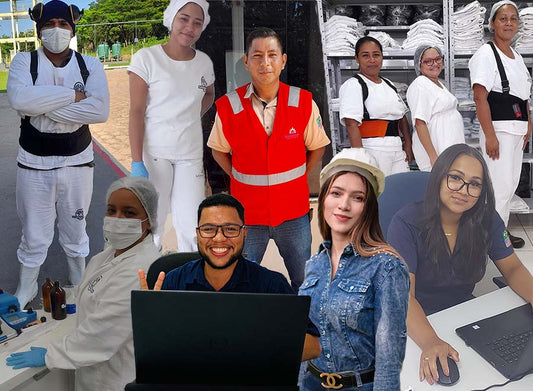Plastic has been an unavoidable part of our lives for many years. It's used in many of our products because it's efficient, easy to work with, and is functional. However, the long lasting nature of the material is damaging to the planet. Decades of improper waste disposal have seriously damaged our planet — which is why we need to look at how to reduce single use plastic. Conventional plastic is a product of extracting and refining fossil fuels for energy. Transitioning away from fossil fuels and towards renewable energy and a healthy climate will encourage the industry to move away from producing wasteful single-use plastics.
Most of our day-to-day activities involve some sort of plastic. These disposable plastics may be convenient and easy to use, but they come at a cost to our environment. While it’s nearly impossible to live a 100% plastic-free lifestyle, by curbing these habits, we can all do our part in reducing our impact on the environment. We know you care about the environment, so here are seven helpful tips on how to reduce plastic use:
1. Use reusable containers
Plastic is one of the most common materials used in modern-day consumer products. Plastic has many positive uses, such as its ability to keep food fresh and safe, but it also has some negative impacts. Plastic takes hundreds of years to break down and can be harmful to both humans and animals. When plastic does break down, it breaks up into very small particles, often naked to the human eye, called microplastics. Fish and other marine organisms have been found to contain microplastics. These microplastics can now be found in our air, water, food… and even human blood. Here are some ways you can utilize reusable containers to reduce your plastic usage in your daily life:
- Capitalize on reusable bags and containers: Use reusable bags instead of plastic bags at the grocery store. Reusable produce bags and food storage containers can be used in place of disposable takeout containers and plastic bags at grocery stores. If you have kids, you can even buy reusable lunch boxes instead of buying paper lunch bags every day.
- Water bottles: Instead of buying water in a plastic bottle from the store, use a reusable bottle. You will save money by not needing to buy new bottles all the time and reduce plastic pollution by not contributing to all those empty plastic bottles in landfills. When choosing a reusable water bottle, look for ones made from glass or stainless steel rather than plastic because they won't leach chemicals into your drink.
- Cups: If you're going out somewhere where you might need a disposable cup (like Starbucks), consider bringing along your own reusable cup!
2. Avoid single-use plastics
Another way to reduce your plastic use is to avoid single-use plastics such as cutlery, plastic straws, or water bottles. Opt for a reusable straw made of stainless steel and opt out of plastic cutlery when ordering take out. At food gatherings, opt for reusable cups and foodware instead of single-use plastic cutlery. The act of reducing single-use plastics is often overlooked. Whether we're throwing away single-use plastics from our daily routines or using them in our homes, it's necessary to reduce their use. This is because many single-use plastics are non-biodegradable and take a long time to decompose while sitting in landfills.
3. Recycle more often
For that reason, you also need to recycle whenever possible — even if it means putting things like milk jugs into recycling bins — because this reduces the amount of new plastic that needs to be made from scratch. You can also extend the life of your plastic by reusing it instead of throwing it away after only one use.
In short, avoid single-use plastics and make sure you recycle all your plastics (including those pesky, hard-to-recycle ones) according to your local guidelines. For instance, many glass bottles are to be washed out and their labels removed before recycling. And if there's no recycling option available for a particular plastic item, try reusing or upcycling it instead of throwing it away.
4. Carry a reusable coffee cup and avoid excessive food packaging
Carrying a reusable coffee cup is a great way to reduce your plastic usage. The average American goes through almost 200 disposable cups a year, so by carrying a reusable one, you're cutting back on an enormous amount of waste. If you have a long commute or spend much time in the car, you can also use the mug there.
In addition to reducing your plastic consumption, this will also save you money since you won't need to buy endless amounts of coffee cups throughout the day. You can also bring mugs from home when you go to a restaurant, allowing you to avoid excessive food packaging.
Remember, it's not just coffee. You can carry your own container to a store and fill it up with anything you like—coffee, tea, cereal, oatmeal, dinner leftovers, or anything in a plastic or cardboard box. This is great for grocery stores that have self-serve bulk filling stations. You'll be cutting down on the amount of single-use packaging you bring home.
5. Carry reusable shopping bags
When you're at the grocery store, do you ever think about whether the food you're buying is wrapped in plastic? As you reach for a bag of chips or a cereal box, do you wonder whether there's some way to avoid using that single-use plastic bag?
Carrying reusable shopping bags with you when going to the supermarket helps reduce the amount of plastic in landfills and waterways. Another way to reduce plastic use is by bringing your own bag to the store when you buy your groceries.
Carrying around reusable shopping bags is a great way to reduce your plastic use. When you go grocery shopping, it's easy to forget to bring your reusable bags. But if you make it a habit, it will become second nature. If you do happen to forget your reusable bags, opt for paper bags at checkout, instead of plastic. You can also buy items in bulk instead of packaging them up individually. That way, you won't have any unnecessary plastic wrap or bags.
6. Change to bar soap and boxed laundry detergent
One of the easiest ways to reduce plastic use is to replace two of the most common household products—soap and laundry detergent—with bar soap and boxed powder. It might seem like a small difference, but this switch will still result in a big impact when you consider how much you use these things. Plus, most bar soaps nowadays come in plastic-free packaging, opting for paper packaging instead of plastic packaging like typical soaps.
There are simple ways to switch to bar soap and boxed detergents instead of liquid detergents. Look for alternative formats for products such as bar shampoos and conditioners, and laundry detergent sheets that dissolve in water. Or, if you don't already make your own laundry detergent, it's only a couple of steps away from pouring powder into the bottle and mixing it.
If that seems like too much work, laundry detergent refill stations are becoming more common, so you can buy a bag of powder and then drop off the used bags at a centralized spot that gets emptied regularly (refillable detergents). These little changes can all make a huge difference in your exposure to plastic daily, and they're so simple that everyone should be able to do them.
7. Buy reusable cutlery
As mentioned earlier, plastic cutlery is one of the many disposable items that are convenient but not necessarily environmentally friendly. Disposable plastic utensils are seen in various venues, from fast-food restaurants to picnics. While convenient for short-term use, the amount of plastic thrown away is phenomenal. In the kitchen, using plastic cutlery is a huge source of unnecessary waste.
An easy way to reduce your plastic cutlery use is to bring or carry around reusable cutlery. You can even purchase reusable utensils in varying sizes that can be washed and reused after each use. For instance, many students are now carrying reusable cutlery to reduce plastic waste on high school and college campuses.
If you remember to bring them with you, you won't have to worry about using disposable ones. This is a great way to reduce the amount of plastic waste you produce each day. So, while it is not always easy to remember your silverware, it is important to try.
8. Use compostable Items or materials with high recycle rates
As the plastic problem continues to get worse, we are all being encouraged to find ways on how to reduce plastic waste, both for environmental and economic reasons. Compostable plastics are one great option for this—they can be used just like any other plastic, but when they're no longer needed, they can be composted rather than end up in a landfill.
Compostable plastics are generally made of corn, sugarcane, and other plant-based materials that microorganisms can break down. They're marketed as a more environmentally friendly alternative to standard plastic products because they decompose into organic material in a compost bin rather than sit around for years and potentially pollute the earth.
You could also choose to use paper, aluminum, or fiber which have high recycle rates. Aluminum doesn’t lose quality when recycled, and can be recycled indefinitely. It has the highest value among recycled commodities and stays in high demand.
Here at SAMBAZON, we are committed to reducing our plastic waste and overall environmental footprint. By the end of 2021, 64% of our retail packaging in the United States was made from post-consumer recycled or plant-based materials. An added benefit of our packaging improvements is that we saved over 360 metric tons of virgin plastic in 2021! That’s the equivalent of 72 African elephants! How did we manage to accomplish this? We switched from plastic to paper for our sorbet pints, lowering plastic usage by 90%. We introduced Ready-to-Eat Açaí bowls with a 100% plant fiber container, and we switched to post-consumer recycled bottles for our fresh juices.
Sustainability drives our business. We are committed to sustainability initiatives (like how to reduce plastic) throughout our business, from operations and product production to social impact work. By 2025, SAMBAZON intends all of its retail products in the United States to be packaged with plant-based and post-consumer recycled materials.
We look forward to serving you the delicious powers of Açaí on your next visit to one of our Açaí Bowl Shops or shopping online and making your own bowls and smoothies at home.
Sources:
- Greenpeace. 9 Ways to Reduce Your Plastic Use https://www.greenpeace.org.uk/news/9-ways-reduce-plastic-use/
- MasterClass. How to Use Less Plastic: 7 Ways to Reduce Plastic Waste https://www.masterclass.com/articles/how-to-use-less-plastic
- National Library of Medicine. Microplastics in Seafood and the Implications for Human Health - PMC. https://www.ncbi.nlm.nih.gov/pmc/articles/PMC6132564/
- ScienceDirect. Discovery and quantification of plastic particle pollution in human blood. https://www.sciencedirect.com/science/article/pii/S0160412022001258







Comments
(0 Comments)Please note, comments need to be approved before they are published.